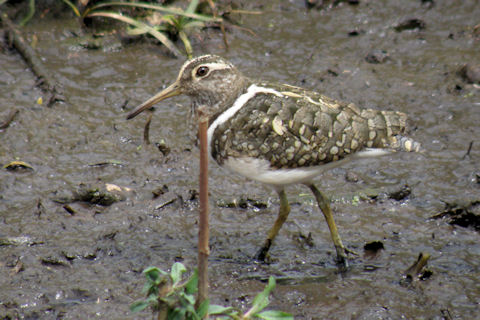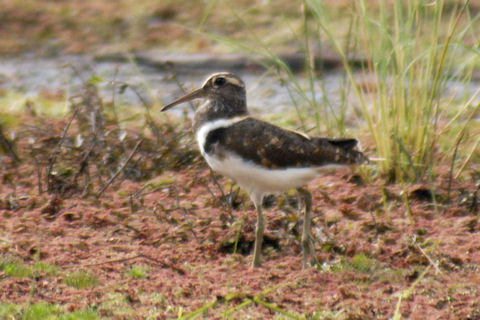Australian Painted Snipe Biography
The female Painted Snipe is more brightly coloured than the male. The throat, neck and head of the adult female is black with a chestnut gloss. There is a pale ring around the eye, a pale stripe on the crown, a pale breast and a pale stripe over the shoulders, extending into a V down the mantle. The wings and back are a metallic green in colour and finely barred with black, bronze and chestnut. The legs and feet are blue-green. The adult male Painted Snipe is smaller with duller colourings. The head, neck and chest is streaked grey-brown, with buff stripes on the back, buff, brown wings and black marbling. Juveniles are similar in colour and markings to the male. This species is also known as the Australian Painted Snipe, or the Greater Painted Snipe
The Painted Snipe is not a true snipe. It is less agile, flies more slowly with legs dangling rather like a rail, and it is nomadic. True snipe are strictly migrants generally arriving in Australia
The Painted Snipe has a scattered distribution in Australia , primarily occurring along the east coast from north Queensland to the Eyre Peninsula in South Australia , and including the majority of New South Wales and Victoria Queensland , throughout Western Australia and the Northern Territory Tasmania
The Painted Snipe inhabits inland and coastal shallow freshwater wetlands, occurring in both ephemeral and permanent wetlands, particularly where there is grass. Individuals have been spotted in artificial dams, sewage ponds and waterlogged grasslands.
The Painted Snipe forages at night on mud flats and in shallow water. It feeds on invertebrates such as worms, snails and water beetles, and plant material such as seeds.
The Painted Snipe nests on the ground amongst tall vegetation such as grass tussocks and reeds. Nests, which consist of a scrape in the ground lined with grass and leaves, are often located on small islands. The female is polyandrous, meaning that she leaves the male to look after the young while she moves on to mate with as many other males as she can attract. Incubation of the eggs and brooding of the young is therefore done by the male alone.
Australian Painted Snipe
Australian Painted Snipe

Australian Painted Snipe

Australian Painted Snipe

Australian Painted Snipe

Australian Painted Snipe

Australian Painted Snipe

Australian Painted Snipe

Australian Painted Snipe
Australian Painted-Snipe (Rostratula Australis)
Pair Of Australian Painted Snipe 26 February 2011
No comments:
Post a Comment